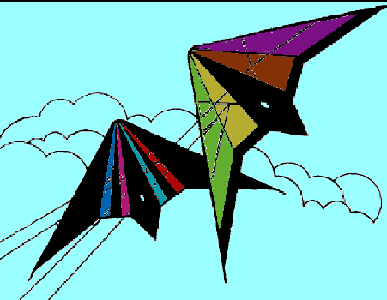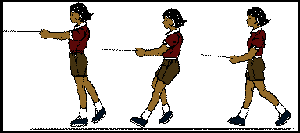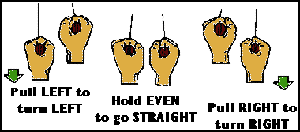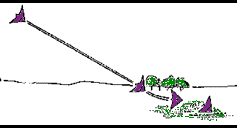Flying Basics for
Dual Line Sport Kites

|
Flying Basics for
|

|
Stunt kites can do things no other kites can do.
In the hands of a skilled flier, your stunter can amaze onlookers as it loops, dives, and dances its way across the sky under complete control.
With a little information and a bit of practice, you can become that skilled flier. Stunt Kites! was written to help you. To get things started, we're providing a few brief excerpts from this useful book which may make your first flight a bit more successful.
Layout and Launching: For beginners, your flying line should be between 75 and 120 feet long. Shorter lines reduce response time and make the kite move too fast for most inexperienced fliers. Longer lines make maneuvers harder to complete. After you unroll the lines, make sure they're the same length and that they're securely fastened to your handles and kite.
|
Have your helper pick up the kite from behind, and hold it by the base and center struts. Keep a little tension between the two of you so that the flylines are off the ground. Now complete the "Pre-launch Checklist". Do everything on this list before every launch. Pre-launch Checklist:
|
 |
On your signal, your helper should give the kite a gentle upward push, then let go. There is no need to be forceful. Just toss it.
And guess what? YOU'RE FLYING!!
 |
For self launches, anchor or "stake" your handles down, then walk back to the kite and stand it up using the flylines as a tension against the wind. Be sure the kite isn't standing straight up when you're done. Unless it leans away from the handles a little, it will try to take off and fly by itself! |
Now go back to the handles and carefully pick them up. Try not to let the kite move and keep equal tension on both lines. Remember your Pre-launch Checklist! Now take three or four quick steps backwards and you're off!!
Steering: There are three and only three basic steering movements. Any maneuver you do, from simple to the most complex, will just be a combination of Left Turns, Right Turns, and Straight Lines. That's all there is to it! Remember that "straight" can mean flying straight in any direction, not just up. Keep turning to the right and you will eventually complete a loop.
The fact that the lines have twisted has absolutely no effect on the way the kite flies. Right is still right and left is still left. To get rid of the twists -- just turn in the other direction.
 |
Pulling back on your handles will make the kite fly faster. Your normal reaction in a crash will be to hold the handles tighter and to pull back on them to try and save the situation. That is exactly the wrong thing to do. You'll just make the kite accelerate and hit the ground harder. |
If you think you're going to crash, try moving toward the kite to slow it down or letting go of the handles.
While you're flying, keep your arms at your sides. Holding them higher doesn't make the kite go up and holding them farther apart only makes you tire more quickly. Let the kite do the flying while you just steer.
|
Picking a Flying Site: Your first flying experience will be much more successful if you find a site with smooth wind and little turbulence. On a field bounded both upwind and downwind by obstructions, you're better off flying as close as you safely can to the downwind end of the field. |  |
Landings: A normal, planned landing takes advantage of the fact that, as the kite flies farther "out" to the right or left, it loses drive and speed. A landing is simply flying the kite to the point where it runs out of forward drive at the same time it reaches the ground.

|
Safety and Courtesy: A maneuverable kite is a PROJECTILE -- capable of doing injury and property damage. Even in a moderate wind, a typical stunt kite can be moving at over 60 miles per hour. If someone gets hit by anything moving that fast, it's going to hurt. |
Always remember the three "C's" of responsible kiting:
Caution, Courtesy and Common Sense.
| FeiLong Kite M.P. : 18363688061 Email: wfkite@163.com |